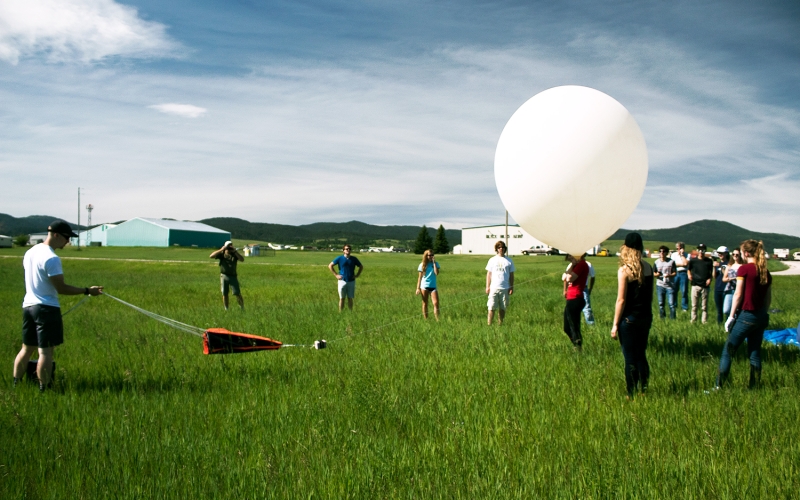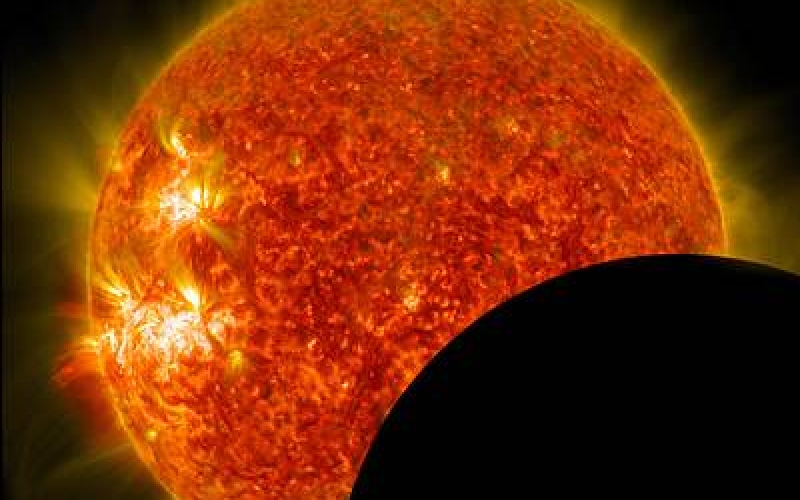Peggy Norris smiles as she recalls her first total eclipse of the sun: It was 1991 in Mexico and it lasted six and a half minutes.
“Until you actually see the sun going total, you just don’t get it,” Norris said. “It’s a visceral, emotional reaction. The sun goes out, and the corona pops in and you get this diamond ring effect when the last bit of light disappears. It’s really, really amazing.”
On August 21, a total solar eclipse will cut a swath across the United States, darkening skies from Oregon to South Carolina as the moon passes between Earth and the sun. It’s the first coast-to-coast total solar eclipse in 100 years. Although Lead is outside that path, the eclipse will reach 95.17 percent.
“It’s not as much of a ‘wow’ factor as a total eclipse,” said Norris, who has attended 15 total solar eclipses since 1991. “Still, there will be some interesting effects and I hope people will go outside and watch it.”
Sanford Lab and the Sanford Lab Homestake Visitor Center are hosting a 95 Percent Eclipse Party beginning at 10 a.m. Monday, Aug. 21, at the Visitor Center in Lead, 160 W. Main. The eclipse begins at 10:27 a.m., reaches its peak at 11:49 a.m. and ends at 1:13 p.m. Cookies and beverages will be served at the free event. (To watch the eclipse, you will need protective certified solar eclipse glasses. Please read the safety tips for watching an eclipse in the article below.)
Norris, deputy director of Education and Outreach at Sanford Lab, will again witness a total eclipse this year when she leads a group of high school and college students, educators and parents for a NASA Eclipse Balloon Launch from Scottsbluff, Nebraska.
The balloon is expected to reach 100,000 feet. Cameras will capture high-resolution photos and live video streaming, while other equipment collects important scientific data during the flight. That data the will benefit researchers wanting to learn more about eclipses.
During a solar eclipse, the moon’s orbit is such that it causes the moon to pass directly in front of the sun, taking more than an hour from “first contact” to totality. In Lead, one little edge will remain uncovered, Norris said. “One interesting thing to look for is that leaves and other things will create shadows that are tiny crescent of the sun. So even though it isn’t a total eclipse, you get some really cool effects.”
“Every eclipse is unique because what’s happening in the sun is different all the time,” Norris said. “The sun goes through cycles. Sometimes you get more cosmic rays or the corona is bigger. And sometimes, you can see coronal mass ejections—ribbons of the sun.”
Solar eclipses occur in Saros cycles, meaning they return to approximately the same relative geometry—almost a straight line—and a nearly identical eclipse will occur every 18 years, 11 and 1/3 days. This year’s total solar eclipse is part of the Saros 145 series. The previous total solar eclipse in this series occurred August 11, 1999. The next one will be on September 2, 2035. The first cycle in this series occurred on January 4, 1639, and the last one will be on April 17, 3009.
Total solar eclipses take place every 18 months somewhere in the world. On average, a total solar eclipse can be seen from the same place only once every 375 years. But there are always exceptions.
According to NationalEclipse.com, an area spanning parts of Missouri, Illinois and Kentucky will be the nexus of the Aug. 21, 2017, and April 8, 2024, solar eclipses in the U.S. “Because the 2017 eclipse travels across the country from northwest to southeast and the 2024 eclipse makes its way through the nation from southwest to northeast, the two paths cross each other and create a zone of overlapping totality of almost 9,000 square miles, or roughly the size of New Jersey,” the site explained.
Since her first eclipse Norris has been to Egypt, Mongolia, Indonesia and Svalbard Island, an International Protectorate that boasts the highest number of polar bears. This year will be her 16th total eclipse of the sun, yet Norris remains as star-struck as she was in 1991.
“I like seeing the world,” she said. “And it’s kind of cool to have the cosmos tell you where to go next. But, really, when you see a total eclipse, it’s like it just brings home the awesomeness of the universe.”
Types of Solar Eclipses
There are four different types of solar eclipses. How much of the Sun's disk is eclipsed, the eclipse magnitude, depends on which part of the Moon's shadow falls on Earth.
- Partial solar eclipses occur when the Moon only partly obscures the Sun's disk and casts only its penumbra on Earth.
- Annular solar eclipses take place when the Moon's disk is not big enough to cover the entire disk of the Sun, and the Sun's outer edges remain visible to form a ring of fire in the sky. An annular eclipse of the Sun takes place when the Moon is near apogee, and the Moon's antumbra falls on Earth.
- Total solar eclipses happen when the Moon completely covers the Sun, and it can only take place when the Moon is near perigee, the point of the Moon's orbit closest to Earth. You can only see a total solar eclipse if you're in the path where the Moon's casts its darkest shadow, the umbra.
- Hybrid Solar Eclipses, also known as annular-total eclipses, are the rarest type. They occur when the same eclipse changes from an annular to a total solar eclipse, and/or vice versa, along the eclipse's path.
From: https://www.timeanddate.com/eclipse/solar-eclipse.html

